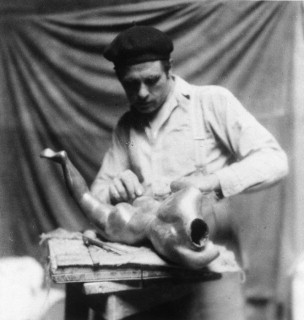Related Research Articles

George Claude Leon Underwood was a British artist, although primarily known as a sculptor, printmaker and painter, he was also an influential teacher and promotor of African art. His travels in Mexico and West Africa had a substantial influence on his art, particularly on the representation of the human figure in his sculptures and paintings. Underwood is best known for his sculptures cast in bronze, carvings in marble, stone and wood and his drawings. His lifetime's work includes a wide range of media and activities, with an expressive and technical mastery. Underwood did not hold modernism and abstraction in art in high regard and this led to critics often ignoring his work until the 1960s when he came to be viewed as an important figure in the development of modern sculpture in Britain.

Margaret Sarah Carpenter was an English painter. Noted in her time, she mostly painted portraits in the manner of Sir Thomas Lawrence. She was a close friend of Richard Parkes Bonington.

Elizabeth Adela Forbes was a Canadian painter who was primarily active in the UK. She often featured children in her paintings and School Is Out is one of her most popular works. She was friends with the artists James Abbott McNeill Whistler and Walter Sickert, both of whom influenced her work. Her etchings in particular are said to show the influence of Whistler.

Ethel Léontine Gabain, later Ethel Copley, was a French-Scottish artist. Gabain was a renowned painter and lithographer and among the founding members of the Senefelder Club. While she was known for her oil portraits of actresses, Gabain was one of the few artists of her time able to live on the sale of her lithographs. She also did etchings, dry-points, as well as some posters.
Bertha Boynton Lum was an American artist known for helping popularize the Japanese and Chinese woodblock print outside of Asia.

Margaret Dorothy Shelton (1915–1984) was a Canadian artist who lived nearly all of her life in Alberta. She worked in a number of mediums but is best known for her block printing.
Helen Francesca Mary Binyon was a British artist and writer. She was also a watercolour painter, an illustrator and a puppeteer.
Phyllis Ethel Ginger was a British artist and illustrator who, although she had a long career in several different media, is now best known for the topographical watercolours she produced during the Second World War for the Recording Britain project.
Marjorie May Bacon, later Marjorie Macbeth-Raeburn was a British printmaker and painter.
Barbara Greg was a British artist who illustrated a number of books.

Mary Viola Paterson was a British painter, wood engraver and colour woodcut artist.
Elizabeth York Brunton was a Scottish artist renowned for her painting in both oils and watercolours as well as her innovative use of colour woodcuts. Although she spent most of her life in Edinburgh, her exhibiting career was mainly overseas.
Doris Boulton later Doris Boulton-Maude, (1892–1961) was a British artist, notable as a wood engraver, etcher and for her colour woodcut prints.

Rachel Reckitt (1908–1995) was a British artist, who in a long career worked as a wood engraver, as a sculptor and as a designer of wrought iron work. Her output included book illustrations, tombstones, church sculptures and pub signs.
Arabella Louisa Rankin was a Scottish painter and colour woodcut artist.
Helen Grace Stevenson was a Scottish artist, most active in the 1920s and 1930s when her colour woodcuts of Scottish scenes proved popular.
Anna R. Findlay (1885-1968) was a British artist and printmaker. She was known for her elegant colour linocut and woodcut prints of mostly topographical scenes.
Mary Elizabeth Groom was a British artist, notable for her work as a printmaker and for the books she illustrated in the 1930s for the Golden Cockerel Press.
Ethel Kirkpatrick (1869–1966) was a British painter, printmaker and jeweller. She was a marine and landscape painter, mainly working in oil and watercolour but also producing woodcuts.
Nellie Marcia Lane Foster later Marcia Jarrett, (1897–1983), was a British artist notable as a printmaker, portrait painter and book illustrator.
References
- 1 2 "Wells, Margaret Bruce". Suffolk Artists. Retrieved 28 March 2019.
- 1 2 3 4 5 6 David Buckman (2006). Artists in Britain Since 1945 Vol 2, M to Z. Art Dictionaries Ltd. ISBN 0-953260-95-X.
- ↑ Alan Horne (1994). The Dictionary of 20th Century British Book Illustrators. Antique Collectors' Club. ISBN 1-85149-1082.
- 1 2 Robin Garton (1992). British Printmakers 1855-1955 A Century of Printmaking from the Etching Revival to St Ives. Garton & Co / Scolar Press. ISBN 0-85967-968-3.
- ↑ "The Collection: The Thrush's Song". Government Art Collection. Retrieved 28 March 2019.